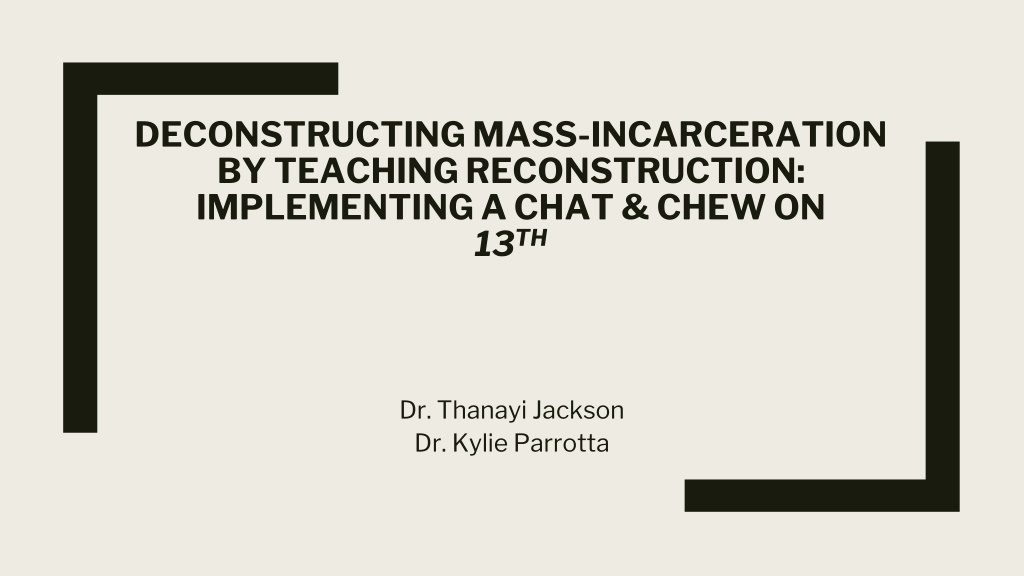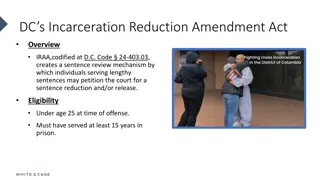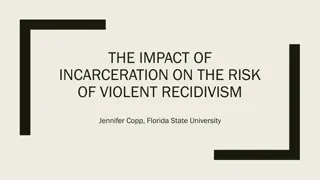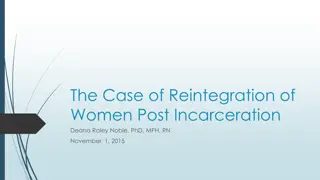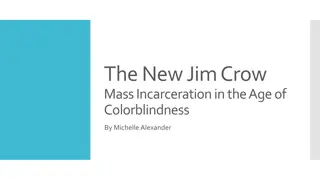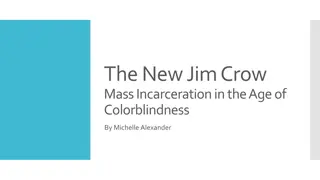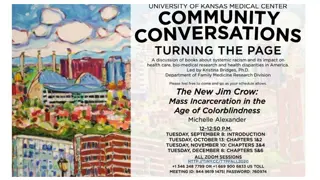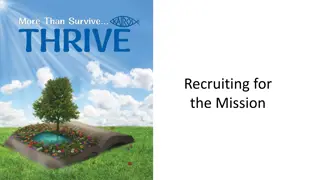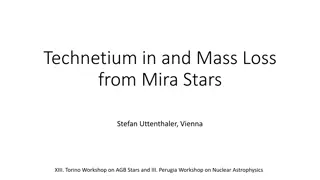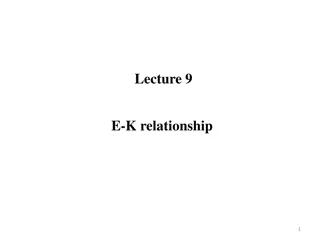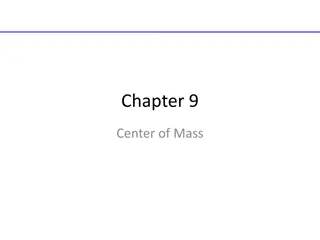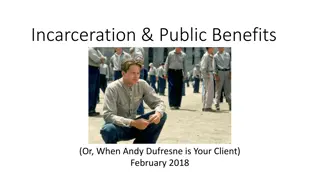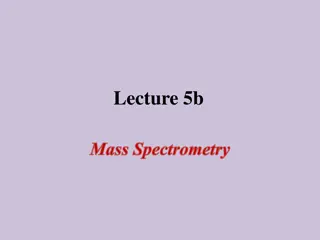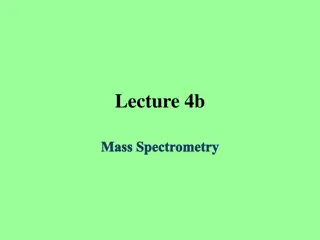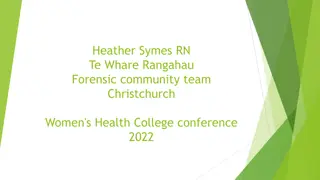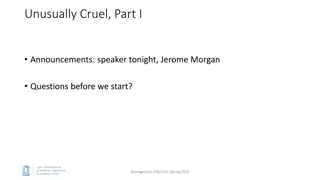Exploring the Impact of the 13th Amendment and Mass Incarceration
Reflecting on the historical significance of the 13th Amendment and discussing its implications on mass incarceration, this educational material delves into the complexities of segregation, colonization within neighborhoods, and the lack of justice faced by Black communities. Activities like Chat & Chew and post-film discussions aim to foster critical thinking and understanding among students.
Download Presentation

Please find below an Image/Link to download the presentation.
The content on the website is provided AS IS for your information and personal use only. It may not be sold, licensed, or shared on other websites without obtaining consent from the author. Download presentation by click this link. If you encounter any issues during the download, it is possible that the publisher has removed the file from their server.
E N D
Presentation Transcript
DECONSTRUCTING MASS-INCARCERATION BY TEACHING RECONSTRUCTION: IMPLEMENTING A CHAT & CHEW ON 13TH Dr. Thanayi Jackson Dr. Kylie Parrotta
13thAmendment Abolition of Slavery Passed by Congress January 31, 1865. Ratified December 6, 1865. The 13th Amendment changed a portion of Article IV, Section 2 Section 1: Neither slavery nor involuntary servitude, except as a punishment for crime whereof the party shall have been duly convicted, shall exist within the United States, or any place subject to their jurisdiction. Section 2: Congress shall have power to enforce this article by appropriate legislation. Writing Prompt: Please read and reflect on the amendment above. Do you know why the 13thAmendment was passed and what lead up to the passing of it? Who do you think supported this Amendment and who do you think was against it? Are you in support of it?
Activity #1 Chat & Chew? In this exercise, the class watches the film and simultaneously chats in real time through the Canvas platform. Allows instructor to call attention to certain parts of the film with pointed questions and comments. Instructors can pause the film at certain parts to unpack comments and questions in the chat and then resume the film. Students are accustomed to consuming media while texting, posting, and chatting. Chat & Chew is a way to see what students are thinking as they are viewing and making connections. Students should do a freewrite on what they learned after finishing the film and before having a class discussion.
Activity # 1 Post-Film Discussion Questions The purpose of the slum is to confine those who have no power and perpetuate their powerlessness. In the slum, the negro is forced to pay more for less, and the general economy of the slum is constantly drained without being replenished. In short, the slum is an invisible wall, which restricts the mobility of persons because of the color of their skin. The slum is little more than a domestic colony which leaves its inhabitants dominated politically, exploited economically, segregated and humiliated at every turn. - Martin Luther King, Jr., Chicago Freedom Festival (1966) Was MLK right? Did segregation create colonies in the United States? These neighborhoods had thick borders maintained by violence and terrorism. Breaking segregation codes was met with fierce punishment. If so, how does policing a colony differ from policing a neighborhood? (See Steinmetz et al. 2017) Are there laws that are written that only apply to those neighborhoods? Are laws implemented and enforced differently in those neighborhoods? How are new laws written after segregation still racialized?
Activity # 1 Post-Film Discussion Questions Questions: If MLK was correct about his interpretation of Black communities: Does it help explain the inability of Black people to receive equal justice under the law? While violence is appalling and criminal, the terrifying part is the lack of repercussions for people who perpetrate crimes against people in those neighborhoods and the lack of justice for victims. Are practices like stop & frisk a violation of Constitutional rights? What would happen if these practices took place in nice neighborhoods? Are arrests more likely to happen and crimes like breaking and entering more likely to be solved in some neighborhoods? Why do some police practices continue even when community members express disappointment and outrage, file complaints, and even protest in the streets? How has the culture of policing changed over the 19ththrough 21stcentury? Why have US police become more militarized and how has this changed community policing efforts? In the current moment of BLM protests, are soldiering and policing the same thing? And if so, does that make MLK s neighborhoods occupied territory?
Activity #2 13thSoundtrack Content Analysis Soundtrack Remix: Is Hip-Hop storytelling? Research the music used in the film. What are the lyrics telling you? When was the song written? What does the song say about the time period in which it was written? What historical social, political, economic, justice issues that were happening at the time of the song s writing does the song reference? What does that say about 2016 (the year the film was made)? Remix 13th: Make your own song. As you watch the film and read the supplemental readings, keep a journal. Then, looking at your notes, chats, and your marked-up readings, select 3-5 of your favorite phrases, or bars, and bring them with you to class. You will then assemble into production teams/studios (breakout groups) to splice, cut, loop, and repeat the various words and phrases of each bar, rearranging them into new bars but according to the groove of history set by the thinkers in the readings. Be passionate about it. Use the words that jump out at you.
Activity #3 Policy Timeline Create a timeline of criminal justice policy and social justice movements in the U.S. since the 13th Amendment was passed. Instructor Note: Depending on the size of the class, you may want to break students into groups to focus on particular decades or geographic locations. Not every policy needs to be on the list, but your group should rationalize why you selected the ones you did. How did these laws or policies impact policing, criminal sentencing, and ideas about punishment and rehabilitation of offenders? Did the policies have any unintended consequences for particular segments of the population?
To Watch Documentaries & Docuseries Pop Culture Watchmen Eyes on the Prize The Wire Reconstruction Birth of a Nation I Am Not Your Negro Birth of a Movement When They See Us The Pharmacist
To Read The House I Live In - Norrell The Fire Next Time - Baldwin The New Jim Crow - Alexander Beale Street Baldwin Why We Can t Wait - MLK Lies My Teacher Told Me Loewen From #Black Lives Matters to Black Liberation - Keeanga- Yamahtta Taylor Are Prisons Obsolete Davis The Hate You Give - Thomas Just Mercy Stevenson Golden Gulag: Prisons, Surplus, Crisis, and Opposition in Globalizing CA Gilmore The End of Policing Vitale How We Get Free: Black Feminism and the Combahee River Collective Keeanga- Yamahtta Taylor Repair: Redeeming the Promise of Abolition - Franke Locked In - Pfaff Prison Land: Mapping Carceral Power Across Neoliberal America Story All Our Trials - Thuma Slavery by Another Name - Blackmon
To Listen Recommended Podcasts Justice in America Voices of Juvenile Justice Reentry Radio Serial Ear Hustle Caught The Appeal
To Do Get Involved Nationally ACLU NAACP Equal Justice Initiative Get Involved Locally Restorative Partners Get on the Bus Alternatives to Violence SLO Public Safety
